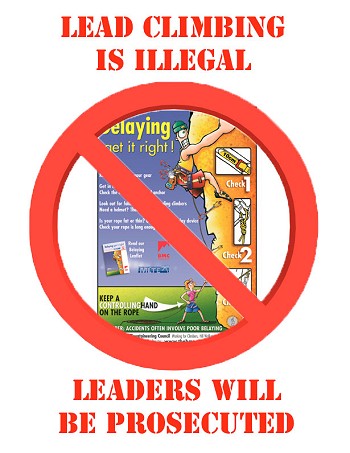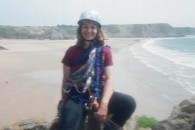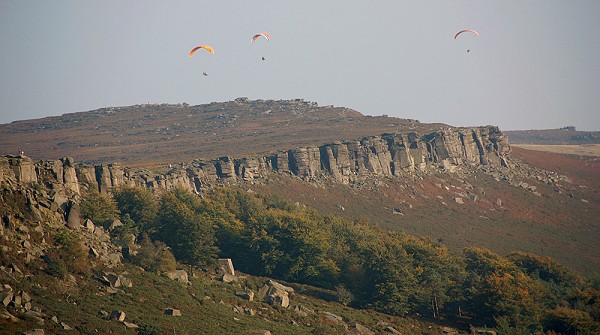

To look at, he was nothing special; and if you were to pass him in the street it is unlikely that you would notice him. His dull, brown hair hung limply over slightly protruding ears. His weathered skin hung in folds below bulging eyes which peered mournfully through dark-rimmed glasses. His nose hung ponderously above terse lips, which opened to reveal the most crooked set of teeth. But for all that, he was not an unattractive man, and although no-one could quite explain why, he enjoyed remarkable popularity with the opposite sex, which increased exponentially as his power grew.
His entrance onto the climbing scene was no more dramatic than his appearance. He turned up to a BMC AGM at a time of considerable disruption, because the “Big Three” clubs, which had hitherto wielded great influence, had all recently resigned on the grounds that most of their members belonged to at least one of the other two. So when it came to the AGM, the totally unknown Top-rope Club, whose two hundred members had fortuitously registered with the BMC a few days before, was the largest club present; and Perkin Blackwell was their representative.
The chair of the meeting was furious at the disloyalty of the Big Three, and went out of his way to make Blackwell feel as welcome as possible because he represented everything those clubs despised. So when Blackwell said he had an additional agenda item, it was received with encouragement and sympathy. The issue he wanted discussed was the unacceptable discrimination that his members had experienced at the hands of more traditionally minded climbers. Ordinarily, the Committee would have had little empathy with this cause, but such was their annoyance with the older clubs that on this occasion they felt minded to indulge it. So when someone proposed that there should be a new BMC post created for Top-roping officer, the President spoke strongly in favour and no-one batted an eyelid when Blackwell cast his two hundred proxy votes to take on the role himself. Before long Blackwell had resigned his insurance job, and settled in at BMC headquarters.
Initially, news of the new officer was greeted with some amusement within the UK climbing world, but it was not long before Blackwell began to make his presence felt. His first coup was to persuade the Mountain Leader Training authority that leading was not an appropriate part of the SPA syllabus; a subject that had been under discussion for some time. This news was greeted with suppressed delight by certain Mountain Instructor Award holders who had supported the proposal behind the scenes, because they expected it to result in more work for them. However, their glee was soon changed to dismay when Blackwell got involved with the HSE and convinced them that not only were the Working at Heights regulations entirely appropriate for climbing instructors, but that they should take a much more proactive interest in all matters related to mountaineering.
Blackwell next turned his attention to the Mountain Rescue Council, and together with his new found HSE comrades, he managed to convince them that they were in imminent danger of being sued. If it wasn't for another of his brainwaves, it is likely that all Mountain Rescue teams would have been disbanded there and then. His proposal was simple and unoriginal; anyone who wanted to set foot on the British hills would have to take out mandatory insurance, otherwise they would be ineligible for rescue. Since the insurance would only be available via the BMC, the management committee were rather pleased about this, as it promised to swell the membership dramatically.
Blackwell's next logical step was to announce that in the interests of health and safety, only MLT award holders would be allowed to lead groups on the hill or crag. In this, he had the full backing of insurance companies, and was able to lean upon his contacts to draw up the measures speedily and unambiguously. He introduced a new award called “Youth Leader Award (YLA)” which everyone including fully qualified guides would have to take before they could lead groups of under 18s. The parents of young participants would now be obliged to sign the BMC parental consent form which was available free as part of standard family membership.
However, it was the next occurrence that caused the most surprise, and it has never been clear to what extend Blackwell was instrumental in this. The International Olympic Committee unexpectedly announced that top-roping was to become an Olympic sport. Although there was not much time to put together a British team, Blackwell rallied to the occasion, and Great Britain came away with the three top medals, which immediately thrust top-roping into the forefront of the British sporting public eye. The BMC's membership was swelled yet again and they were awarded a massive grant from the Sports Council to develop the event still further.
By then the top-roping tidal wave was unstoppable, and it was not long before all the major crags in the UK were fully equipped. Traditional climbing was declared illegal due to its obvious Health and Safety implications. In deference to a bleating minority, bolted leading on multi-pitch crags was tolerated in accredited locations, where chains were installed on the stances, which were enlarged as appropriate to make them safer.
Interestingly, the greatest beneficiary of all this was the Peak District and its inhabitants, especially those living near Stanage, which became internationally renowned as an outstanding top-roping resort. A permanent warden was appointed to inspect the equipment and refashion the holds when they became too worn. In recognition of its services to tourism, the BMC was acclaimed for sports management excellence, and Blackwell, their newly elected President, was decorated in the New Year's honours list.
Sadly Blackwell passed away at the premature age of 42. It is not known exactly what he was doing, but he had taken an interest in a new activity called “extreme top-roping” which entailed seeking out distant crags and setting up top-ropes in scenic beauty and privacy. It is thought that Blackwell was concerned about the overall safety of this activity and was seeking ways to regulate it.
His body was found at the foot of a remote Scottish cliff and his top-rope lay draped haphazardly over him. No partner was evident and it appeared that he had been attempting to extreme top-rope whilst self-belaying. His rope must have sheared over a very sharp edge, although no obvious protuberance could be identified. But some say a mysterious cackling figure was seen disappearing into the mist as Blackwell breathed his last.

















Comments